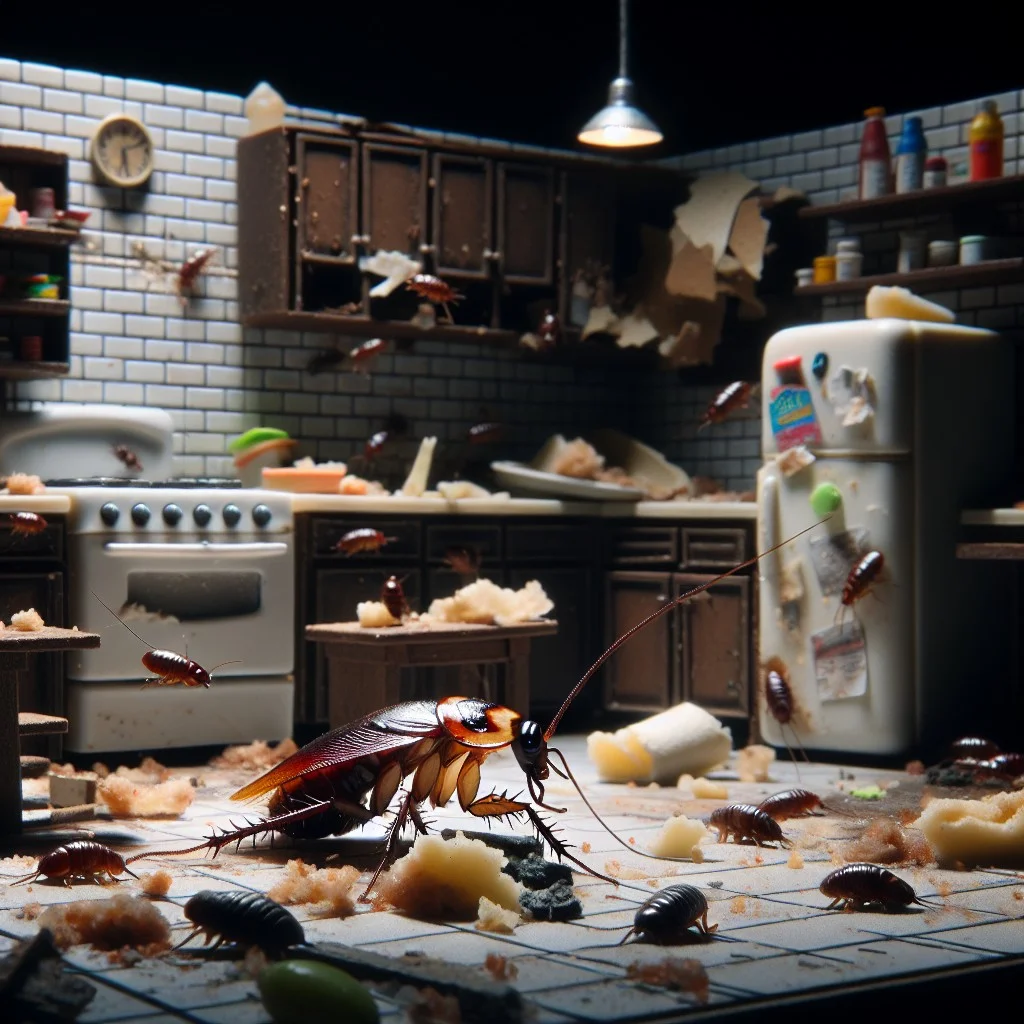Last updated on
Understanding how to deal with roaches in your kitchen can be simplified by exploring efficient pest control methods, learning about their behaviors, and adopting preventive measures.
Key takeaways:
- Signs of a Cockroach Infestation*: Droppings, smear marks, egg casings, shed skins.
- What Attracts Cockroaches to Kitchens*: Food scraps, moisture, clutter, warmth/darkness.
- How to Prevent Cockroach Infestation*: Cleanliness, fix leaks, pet food storage, declutter.
- Best Solutions for Roach Control*: Professional treatment, gel bait, boric acid, hygiene.
- How to Get Rid of Cockroaches in the Kitchen*: Eliminate food sources, use baits/traps, consider insecticides.
What's Inside
Signs of a Cockroach Infestation

Cockroaches are stealthy pests, but they do leave evidence of their presence. Spotting one roach often means there are others lurking unseen. Keep an eye out for droppings, which resemble black pepper or coffee grounds and are often found in drawers or under the sink.
Unusual, musty odors can also indicate a roach problem, as these pests emit pheromones. Look for smear marks where water is abundant, as cockroaches tend to leave dark, irregular shaped marks along walls or floors when they move.
Egg casings (oothecae), which hold many eggs, are a clear sign of a roach infestation. They’re typically oval-shaped and can be found in hidden areas like between books or in pantry corners.
Lastly, check for shed skins as cockroaches molt multiple times throughout their life cycle, and these skins can often be found near their hiding spots. If you notice any of these signs, it’s time to take action to prevent a full-blown infestation.
What Attracts Cockroaches to Kitchens
Cockroaches come to kitchens mainly in search of three critical resources: food, water, and shelter.
Food Scraps: These pests are not picky eaters, and even the smallest crumbs can serve as a feast. Ensure no food is left out, crumbs are swept up, and food is stored in airtight containers.
Moisture: Leaky pipes or standing water are like a desert oasis to cockroaches. Repair any plumbing issues and wipe down wet countertops.
Clutter: Stacks of cardboard, unused appliances, and piles of grocery bags create ideal hiding places. Declutter your kitchen to remove potential shelters.
Warmth and Darkness: Kitchens are warm and often have hidden dark spots, perfect for roaches seeking a cozy breeding ground. Regular cleaning underneath appliances can reduce these hiding spots significantly.
By understanding and eliminating these attractions, you strike at the root of what makes your kitchen appealing to roaches.
How to Prevent Cockroach Infestation in Your Kitchen
Maintain cleanliness by wiping down surfaces and sweeping floors daily to remove crumbs and spills, which are a banquet for roaches. Store food in airtight containers and avoid leaving dishes in the sink overnight. Regularly emptying the trash and using bins with tight-fitting lids can also cut down on odors that attract these pests.
Fix leaks immediately, as roaches are attracted to moisture and water from a dripping tap provides them with a drink. Sealing entry points such as cracks and crevices in walls, around baseboards, or behind electrical sockets with caulk can block their access to your kitchen.
Consider storing pet food away after feeding times and avoid leaving bowls out overnight. Managing clutter, especially stacks of paper or cardboard, removes potential roach hiding spots and breeding grounds.
Implement these simple yet effective strategies to create a hostile environment for roaches, significantly reducing the risk of an infestation.
Best Solutions for Roach Control: Professional and DIY
Getting a handle on a roach problem requires a multi-faceted approach, blending both professional treatments and do-it-yourself (DIY) methods.
Professional extermination offers a powerful punch against severe infestations. Experts employ methods such as:
- Baiting systems that lure roaches with food and then poison them.
- Insecticidal dusts, getting into the nooks where roaches hide, providing a long-lasting barrier.
- Fumigation, which is a last-resort option but effective for pervasive problems.
If you’re going the DIY route, consider these strategies:
- Gel bait can be applied under appliances and in corners. Roaches ingest the gel and die, often back at their nest, which can help reduce the population.
- Boric acid is a classic. Sprinkle it in problem areas, but be mindful of pets and children.
- Hygiene is paramount. Regularly clean counters, eliminate water sources, and seal food in airtight containers.
- Essential oils like peppermint or neem oil can deter roaches, adding a pleasant scent to your kitchen.
By combining professional expertise with diligent home efforts, you create an unwelcoming environment for roaches, tackling infestations at the source and preventing future unwelcome visitors.
How to Get Rid of Cockroaches in the Kitchen
Eradicating cockroaches from your kitchen hinges on a combination of cleanliness, strategic baiting, and sometimes, chemical interventions.
Begin by eliminating their food sources; store food in airtight containers and avoid leaving dishes out overnight. Clean spills and crumbs promptly, being sure to vacuum or sweep regularly, paying close attention to hidden areas under appliances and cabinets where food particles can accumulate.
Next, use baits and traps. Gel baits can be applied in crevices where roaches are likely to travel. Roach traps can be placed in strategic locations to reduce the adult population. Remember to replace these regularly for maximum effectiveness.
For persistent problems, consider insecticides. A carefully applied roach-killing spray can be effective, but ensure it’s safe for indoor use and follow manufacturer instructions closely to protect your health and your family’s. In extreme cases, a professional exterminator might be your best option, utilizing more potent chemicals and methods to clear the infestation.
Always keep your kitchen well-ventilated after using any chemical solutions and use these methods as a last resort, prioritizing natural and non-toxic approaches whenever possible.




